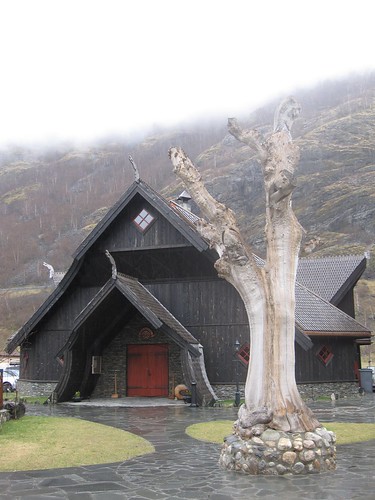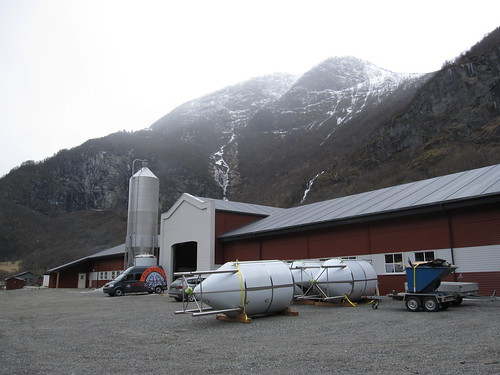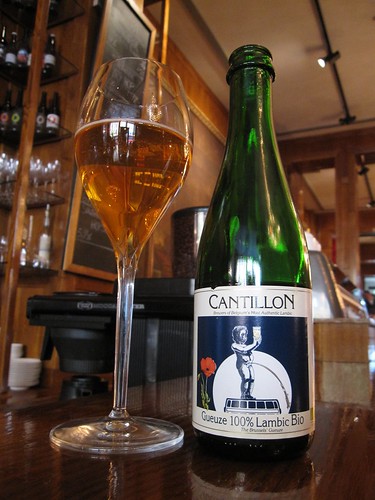In August 2015 I found myself on Gotland for the Medeltidsveckan medieval festival which is held in Visby, the only real town on the island. Together with a friend I had a few days available for a short road trip, so we ended up driving around most of the island in search of good food and beer. I may write a post about some of the other breweries and places we checked out, but this post is about the Barlingbo Bryggeri and their collaboration with Fårögården Restaurang which resulted in the opening of a new brewery this summer.
 |
| Fårögården Restaurang, the home of Fårö Bryggeri |
Fårö Bryggeri
Fårö is a large island just off the north-western tip of Gotland, connected by a ferry which runs around the clock and takes about 5 minutes to cross the Fårösund strait. Driving there takes about 90 minutes from Visby, so we're not talking long distances. The island is probably best known for its association with movie director Ingmar Bergman, it was his home for many years and now his final resting place. But the island also offers a very scenic coastline with impressive seastacks, known as rauks in the local dialect, standing up to ten meters tall, eerily resembling the tall Moai heads on Easter Island.
It makes sense to stay at least one night when you get to Fårö and for that Sudersands Semesterby offers the largest accommodation, you can either rent one of the myriad of cabins there or put up your own tent. I don't know about the winter season, but during summers Sudersand is teaming with guests, most coming for the great sandy beaches or for the annual Harley Davidson Rally which attracts hundreds if not thousands of bikers to Gotland and Fårö every August.
Most guests will be more than happy with the restaurants and fairly standard beach bars at Sudersand, but if you're willing to hike about 20 minutes west along Fårö Simunds you'll be treated to much better food and beer at Fårögården Restaurang. As the name implies ("gård" means "farm" in Swedish), Fårögården is also a farm, where they raise lambs among other animals. They also have a bed & breakfast service, so you can actually stay at Fårögården instead of Sudersand.
 |
| Leg of locally raised lamb at Fårögården Restaurang |
Fårögården Restaurang aims at serving good local food, often using ingredients from the farm. One of the dishes they offered during my visit was a leg of lamb that turned out to be the best meal I had on Gotland. The lamb had been raised on the farm, so it was really short traveled food; the leg was cooked with low heat for many hours, so the meat was really tender and juicy, and served with a chevre & honey cream, pesto and polenta cakes and tasty chorizo sausages.
Inside the restaurant a small microbrewery opened up in June 2015, named Fårö Bryggeri or Fåröbryggeriet. The small 50 liter brewery is the old test brewery from Barlingbo Bryggeri, so Fårö Bryggeri can be viewed as a sort of test brewery for Barlingbo. The idea is to test new recipes by brewing them on the small microbrewery and serve the beer at the restaurant to find out which are good enough to be scaled up for brewing at the much larger Barlingbo brewery. Naturally, Fårö Bryggeri will also brew some standard "house ales" for the restaurant, not only experimental beers.
All the beer brewed at Fårö Bryggeri is sold exclusively at Fårögården Restaurang, so this is where you have to go to try these beers. Because the batches are so small everything is bottled by hand, nothing is kegged, so you'll find a pretty good beer menu with perhaps a dozen different beers. The only problem is that the small batches will quickly sell out, so perhaps only 8-10 of the beers will be available at any time. Still, that's plenty enough for spending a nice evening at the restaurant.
 |
| A bottle of Gasmora smoked ale at Fårögården |
Among the beers offered at Fårögården Restaurang during my visit was both a wheat ale brewed with raspberries, a heavily smoked ale and a strange herbal concoction. The weirdest beer I tried was Barlingbo Ekeviken, a 6.3% abv wheat ale brewed with mint and pineapple! The mint totally dominated the flavor and reminded me of tooth paste. This may not be everyone's cup of tea, certainly not mine, but I heard other people expressing their delight. For me it was the Gasmora smoked beer, brewed at Fårö despite the Barlingbo name on the label, which impressed the most. It was heavy on the bonfire smoke, but was well balanced thanks to a rich, sweet malt body that brought my thoughts to the malty rauchbiers of Bamberg.
While at Fårögården we happened to meet Jonny Warg, one of the founders of Barlingbo Bryggeri, who was up there to check on the test brewery. We talked for a good while and at the end of the evening he invited us to visit the Barlingbo brewery when we returned to Visby a couple of days later.
 |
| Stafva Gård - the home of Barlingbo Bryggeri |
Barlingbo Bryggeri
Stafva Gård in Barlingbo, about 10 km east of Visby, is known for its cheese production and now also for its brewery, after Barlingbo Bryggeri launched its first beer in June 2014. Of all the breweries I tried on Gotland, Barlingbo was the one that impressed me the most, offering a range of excellent beers in classical styles such as lager, pale ale, ipa and porter to more experimental types.
As we drove back to Visby, bearing the invitation from Jonny Warg in my mind, we made a stop at Roma Abbey, both to visit the old ruins and to let me make a phone call to Mr. Warg. As the CEO of Barlingbo Bryggeri, I knew he would be busy on a Friday but when I phoned him he was more than happy to receive extra visitors. "Can you be here in ten minutes?", he asked. "No problem", I replied, with a sigh of relief. Roma Klosterruin is just a few minutes drive from Stafva Gård, so we immediately got into our car, drove to Stafva Gård were we parked less than ten minutes later. Jonny Warg was already waiting outside the main entrance to the brewery and greeted us with a wide grin when we got out of our car.
After we had donned special protective foot gear, to avoid bringing any dirt or farm soil with us into the brewery, Warg took us on an excellent tour. He told us that most of the brewery equipment were either bought used or have been re-constructed from earlier use in dairy production. For instance, the 1500 liter brewing kettle was formerly used for making cream, while the bottling line was an old German make from 1967, which has been upgraded with modern electronics and soon will be able to run "double vacuum" when filling bottles with beer.
As mentioned, the brewing kettle can produce up to 1500 liter wort, but there are plans to replace it with one of 1800 liter which is much better suited to fill up their 5000 liter fermentation tanks, since two brews will then produce up to 3600 liter (you never fill up the tank 100% as you need to let the beer ferment and release CO2).
For hopping their beer, Barlingbo prefer to use whole hops, not pellets or extract, so they have constrcucted a special hop cage ("humlebur") of chicken wire, over a meter long, 20-30 cm wide and half a meter tall, that they fill with hop cones and submerge in the beer.
 |
| Jonny Warg showing us the labeling machine at Barlingbo |
The maximum capacity of the bottling line is 7500 bottles per hour, though they usually run it at a slower speed of 3600-4200 per hour, to allow for better CO2 control. Currently the bottling operation requires much manual labor, such as lifting the empty bottles onto the belt and packing the filled ones into cases, so Jonny Warg considers constructing a robot for lifting the bottles onto the bottling line. Their labeling machine is also well used, in a former life it was used by Dugges Ale- og Porterbryggeri and before that by Oppigårds Bryggeri.
After the interesting tour of the brewery we were taken to the lab, where we were introduced to Barlingbo head brewer Niklas Gustafsson, a big smiling man with a huge beard. There I got the chance to try some of their new beers. I was first given a taste of their first ever lager, which was bottles unfiltered and had a strength of 5.6% abv and bitterness of 26 IBU, Named Holmudden, the lager was actually brewed at Fårö Bryggeri, so only 150 liter was made, but it had been lagered (matured on cold tanks) at Barlingbo, where it was also bottled. The lager turned out to be a very tasty Munchener style helles, with a good malt flavor and elegant hops provided by Perle and Tettnanger, it was fairly dry overall and very drinkable. After this tasty and refreshing lager I was given a taste of a real beast, their 13% abv imperial stout. About a year ago they brewed 900 liter of this beer which has been aging on tank ever since. It smelled of coffee and chocolate and had a rich but soft, creamy mouthfeel. It was very balanced, with a tasty black chocolate bitterness lingering in the aftertaste. In my view this beer is ready for release, as soon as they can find a good name for it :)
I'm very grateful for the wonderful treatment we received at Barlingbo Bryggeri and for the generous amount of time that Jonny Warg and Niklas Gustafsson spent on us. Thank you very much guys!
Currently, the beers from Barlingbo Bryggeri are mainly available on Systembolaget and at better beer bars in Stockholm and on Gotland. In addition to the already mentioned Fårögården Restaurang, there are usually some Barlingbo beers available at the Black Sheep Arms pub in old town Visby. I can also personally vouch for the excellent selection of beers at Karlsörestaurangen on Stora Karlsö in the south of Gotland, which is only open during the summer months.
 |
| Niklas Gustafsson and Jonny Warg of Barlingbo Bryggeri |
More photos from Fårö and Barlingbo Bryggeri can be found at Flickr.

















